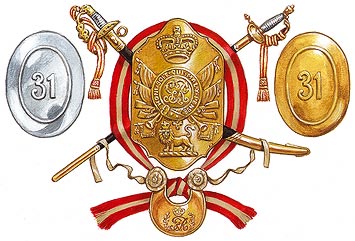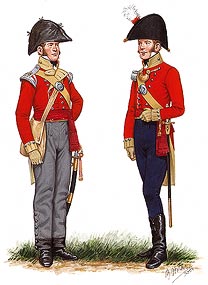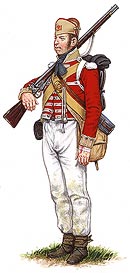Battle of Albuhera 1811

 |
| On the left an Officer of the Grenadier Company with his hat covered in oiled silk. On the right an Officer of a Battalion Company wearing pantaloons and boots. |
The 2nd Battalion of the 31st (Huntingdonshire) Regiment (the 2/31st) was raised in 1805 and was to serve in the Iberian Peninsula Campaign under Sir Arthur Wellesley, later the Duke of Wellington. The Battalion distinguished itself during the Battle of Talavera in 1809, though losses were high. 1810 was a year of consolidation, but in the spring of 1811, the French Marshal Soult marched to attack General Beresford’s allied force, which was besieging the town of Badajoz. The 2/31st was in Beresford’s army, which occupied a defensive position near Albuhera on the evening of the 15th May; the following day was to be one of the bloodiest battles ever fought by the British Army. Beresford’s force consisted of about 32,000 British, Spanish and Portugese troops.
 |
| A Private of the Battalion Company. He is wearing the folding forage cap of the period, which was superceded by the blue, flat topped cap with facing coloured band towards the end of the Peninsula War. |
Soult launched a feint at the centre of Beresford’s position and the British general believed that the main assault would occur there. However, a strong French force, including nineteen infantry battalions suddenly appeared from the south, which threatened the allied right flank. The Spanish infantry, which was mainly responsible for the right held their position as best they could, but Major-General Stewart moved his division up to support them. The first British brigade on the scene was Colborne’s; this included the 2/31st, who advanced in line in order to pour the maximum fire into the French columns. However, under the cover of a hailstorm, Soult’s Polish Lancers charged into the Brigade and decimated three battalions. The 2/31st‘s discipline was outstanding, as the Battalion managed to form square and escaped heavy loss, but the line was broken and it took some time to gain control. The 2/31st then joined the next reinforcing brigade of Hoghton. There were now about 3,700 allied troops facing 8,000 Frenchmen at twenty to thirty yards apart, exchanging volley after volley for about an hour. Casualties were high until the French were finally driven back by the 7th and 23rd Fusiliers. In seven hours, the allies had lost 6,000 men compared with 7,000 French. The 2/31st had 155 casualties out of 398; both sides claimed victory, the French had not relieved Badajoz, but the allied army had paid a high cost and did not pursue their enemy.
Albuhera became a major Regimental Day after the various amalgamations and the formation of The Queen’s Regiment in 1966. This was because both The 3rd, East Kent Regiment or Buffs and The 57th (West Middlesex) Regiment, who earned the nickname The “Die Hards” from the Battle, participated. The Princess of Wales’s Royal Regiment of today continues to remember the Battle. Both The Queen’s Regiment and its successor, The Princess of Wales’s Royal Regiment, have celebrated the annual Silent Toast Ceremony on the 16th May, when the officers and warrant officers drink the toast “To the Immortal Memory”. This is in memory of all those officers and men from the current and forebear regiments, who have given their lives in the service of their Sovereign and 57th’s casualties at Albuhera.
Marshall Soult - The Battle of Albuhera
(Click image to enlarge)

